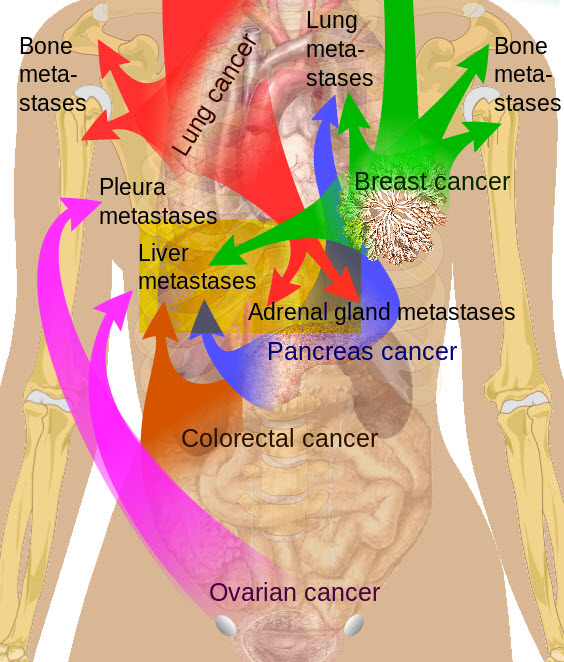But it's been pondered for almost a hundred years. It was postulated that metastatic cells spontaneously caused secondary tumors by fusing their cellular material with regular cells and re-establishing their errant gene expression, but spontaneous is not a concept scientists like, so the search for the real causes has been ongoing.
Sequencing technology has caught up to speculation and reporter molecules are advanced enough to tackle the topic, so researchers recently cultured healthy cells and tumor cells that "spontaneously" fused to form hybrids. Using RNA-seq, the group took a molecular snapshot of the gene expression of each fused hybrid cell. The resulting hybrids were found to express the genes of both the healthy cell and the tumor cell. This factor aids metastatic cells in surviving the primary tumor and potentially helping lay the groundwork for other tumor cells.

Examples of metastases and primary cancers. Imageby Mikael Häggström via Wikimedia Commons CC-BY-SA-3.0
The group engineered mice that produced an inducible reporter enzyme called luciferase when hybrids were present. Rather than using bioluminescent macroscopic imaging, which lacks the sensitivity to detect cells scattered across a specimen, they developed a technique that stitched together hundreds of microscopic images to detect luciferase. This allowed them to track hybrid formation in living animals for the first time. Sites where the mice expressed luciferase lit up, indicating that hybrid cells were forming spontaneously in vivo.
The metastases showed a significantly higher proportion of hybrid cells than the primary tumor.
By studying distinct heterogenous gene expression profiles found in human hybrid cells and how hybrid cells spontaneously occur in mouse models, it may be possible to bypass the tremendous difficulties in creating many different therapies to target different tumor cell types and perhaps make it possible to quell heterogeneity at the source by limiting hybrid formation in the tumor.
Further research on how hybrids form may lead to development of drugs to inhibit hybrid formation and prevent metastatic spread.






Comments